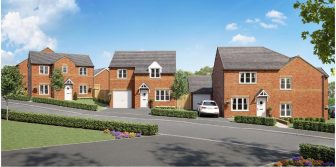 Buyer demand in the new build market remains high, reflected by the latest figures, which show that new homes reservations are up 7% in the first quarter of the year compared with the same period in 2021, and 41% up on pre-pandemic reservations in Q1 2019.
Buyer demand in the new build market remains high, reflected by the latest figures, which show that new homes reservations are up 7% in the first quarter of the year compared with the same period in 2021, and 41% up on pre-pandemic reservations in Q1 2019.
New research from Savills suggests that limited choice across the housing market, especially for larger second-hand properties, has prompted many buyers to consider new build for the first time.
However, the combination of limited construction materials and slow planning decisions means supply of new homes is declining.
Savills finds completions have been declining for the past three consecutive quarters, with only 238,500 new homes being built in the year to Q1 2022 – a 7% drop on the peak of 255,000 at the same time in 2020.
George Cardale, head of residential development sales at Savills, commented: “Bricks, cement and roofing products have all become increasingly difficult for housebuilders to source, as well as being more expensive to produce, due to the rising cost of energy. Not only is it increasingly costly for developers to build, but a fall in the number of consents granted since the peak of 2019 is creating intense competition for sites to build on.
 “Meanwhile, across the UK, we are seeing an imbalance of buyer demand and the availability of new homes. There are people ready and waiting that are keen to move into their next home but stock continues to be an issue.”
“Meanwhile, across the UK, we are seeing an imbalance of buyer demand and the availability of new homes. There are people ready and waiting that are keen to move into their next home but stock continues to be an issue.”
The fact that new build stock is typically more energy efficient than second-hand stock is another reason why buyer demand is growing.
As a result of the cost of living crisis buyers are becoming increasingly conscious of the cost of running their homes, with 68% of respondents to Savills’ most recent buyer survey stating that EPC rating were important when deciding to buy a home. One third of respondents said they placed more importance on EPC ratings now than they did a year ago.
Between 2018 – 2020, the majority of new builds transacted achieved a grade B on their EPCs, compared to a ‘D’ for a second-hand detached, semi-detached or terraced property and ‘C’ for a flat.
Savills looked at energy bill savings for the same property type and found that those buying new build houses would be looking at potential bill savings of over 50% when compared with second hand homes (table below).
Projected annual ‘core’ energy bills of new build vs second hand by the end of 2022
|
|
New Build |
Second Hand |
|
|
||
|
Property Type |
Most common EPC rating transacted |
Projected ‘core’ energy costs per year* |
Most common EPC rating transacted |
Projected ‘core’ energy costs per year* |
Projected savings in energy costs per year by purchasing new build |
% saving |
|
Detached |
B |
£941 |
D |
£2,104 |
£1,163 |
55% |
|
Semi-detached |
B |
£744 |
D |
£1,793 |
£1,049 |
59% |
|
Terraced |
B |
£720 |
D |
£1,724 |
£1,004 |
58% |
|
Flat |
B |
£596 |
C |
£939 |
£344 |
37% |
**Combined estimated cost of lighting, heating and hot water from EPCs on homes transacted between 2018-20, inflated by projected rises in energy bills
 Source:Savills research using EPCs and HM Land Registry
Source:Savills research using EPCs and HM Land Registry
In November 2021, the government announced that every new home with on-site parking is to have an electric vehicle charging point, this will increase the number of charging points by 145,000 each year.
Sophie Tonge, research analyst at Savills, said: “Developers who make the extra effort to go beyond the minimum requirements are likely to better future-proof their developments and entice a larger pool of buyers who are increasingly motivated by cleaner and cheaper ways of living.”


Comments are closed.